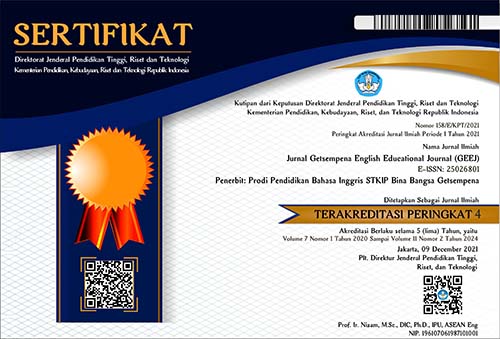THE ANALYSIS OF ENGLISH NATIVE SPEAKER AND ESL TEXTS USING FARS APPROACH
Abstract
This research was a comparison of ESL’s and native speaker (NS)’s texts in achieving a coherent text. This study aims at investigating the frequency or the number of occurrence of relations, hierarchical structures, and functional relations; paratactic and hypotactic and also to find out the recursiveness occurrences within schema constructed as well as the explicitness of signalling from the two texts analyzed. Both texts were scrutinized based on FARS approach. Each of the texts was segmented into several segments, categorized based on FARS relations and determined in terms of functional relations. The findings indicate that the ESL learner’s text was the hypotactic relation which tends to dominantly use cohesive devices or conjunctions within the text in order to elicit a coherent text. On the other hand, there is an equal number of paratactic and hypotactic relation in NS’s text as it shows the dominant use of elaborative relation in the text. Referring to recursiveness occurrence, text 1 (NS) has three highest occurrences of recursiveness; Elaboration Amplification, Framing and Elaboration Extension, while text 2 (ESL) has two occurrences; Elaboration Amplification and Framing. Then, in text 1, it is implicitly comprehended that the writers apply implicit signalling beyond the clauses indicated by the low occurrence of conjunctions which shows higher English proficiency of the writers. However, text 2 does not employ any implicit signalling identified by higher number of conjunctions employment beyond the clauses. All of these features found in the texts are possibly linked to the linguistic, type of texts and cultural backgrounds of the writers.
References
Golebiowski, Z. (2009). The use of contrastive strategies in a sociology research paper: A across-cultural study. In E. Suomela-Salmi, E &F. Dervin. (Eds.,), Cross-linguistic and cross-cultural perspectives on academic discourse (pp. 165-185). Amsterdam: John Benjamins Publishing.
Golebiowski, Z. (2006). The distribution of discoursal salience in research papers: Relational hypotaxis and parataxis. Discourse Studies, (8(2), 259-78, retrieved 12 June 2009, Sage Premiere database.
Golebiowski, Z. (2004). Description of FARS relational clusters and definitions of relations. Deakin University.
Golebiowski, Z., & Liddicoat, A. J. (2002).
The interaction of discipline and culture in academic writing. Australian Review of Applied Linguistics, 25(2), 59–71.
Sabarniati, S. (2012). Interlanguage (course assignment submission). Melbourne: Deakin University.
Swales, J. (1990). Research articles in English. Genre analysis (pp. 110-176). Cambridge University Press.
























